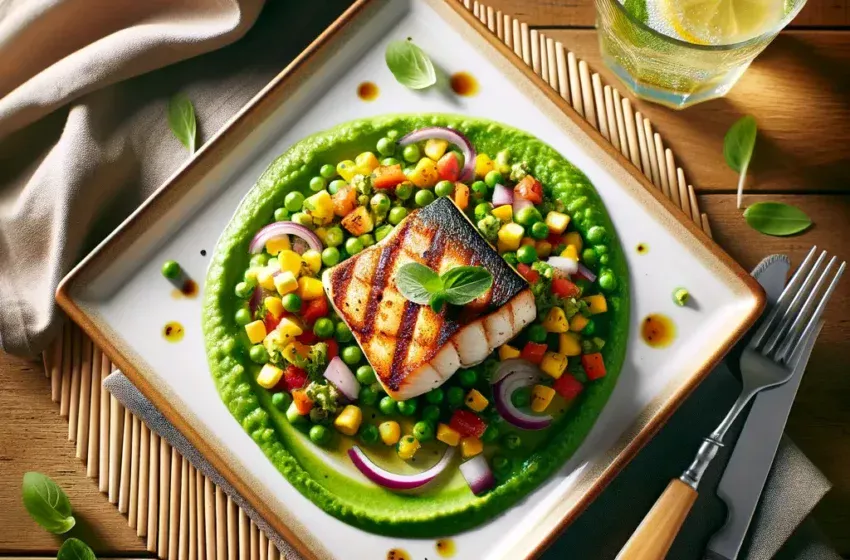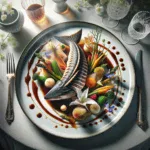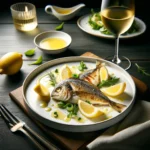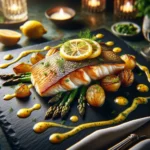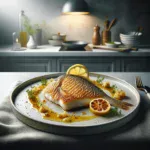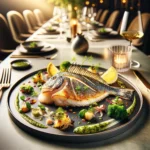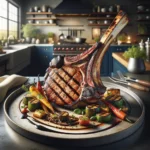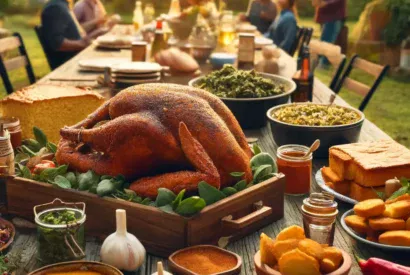Corvina Recipe: A Culinary Delight
As a seasoned food reviewer, I’ve had the pleasure of savouring dishes from around the globe, but the simple elegance of a well-prepared Corvina stands out. Today, I’ll share a cherished recipe that brings the ocean’s bounty to your table with finesse and flavour. Follow these detailed steps, and I’ll also sprinkle in some pro tips to elevate your dish, discuss its health benefits, and wrap up with a conclusion that encapsulates the essence of this delightful meal.
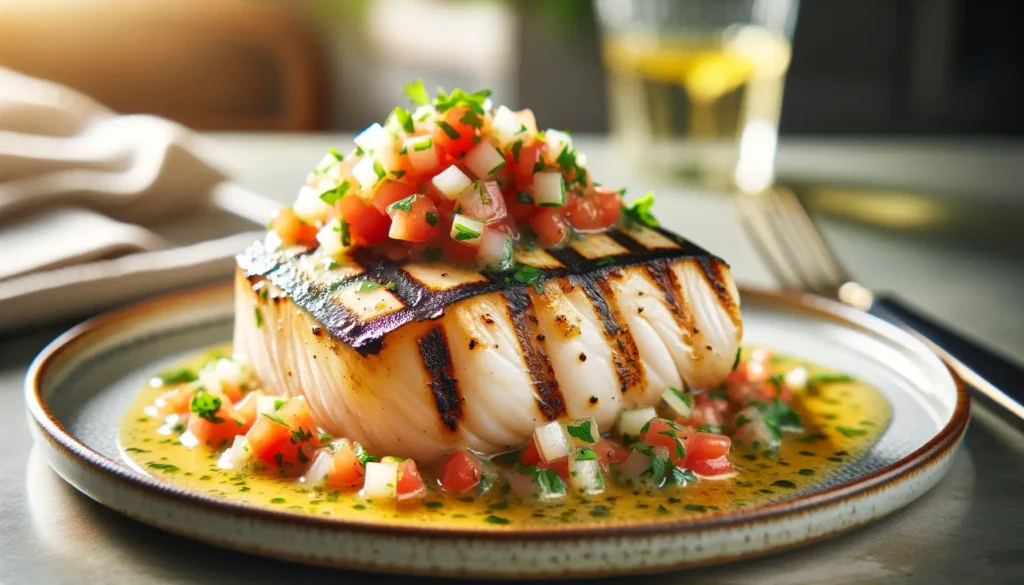
- Preparation Time
15 minutes - Cooking Time
15-20 minutes - Serves
4 adults - Difficulty
Easy
Way to Prepare Corvina Recipe
Ingredients
- 4 Corvina fillets (6 ounces each)
- 2 tablespoons olive oil
- Salt and freshly ground black pepper, to taste
- 1 lemon, sliced
- 2 cloves garlic, minced
- 1/2 cup white wine
- 1/4 cup fresh parsley, chopped
- 2 tablespoons unsalted butter
Instructions
- Step 1: Preparing the Corvina
- Preheat your oven to 400°F (200°C). This ensures a consistent cooking environment for the fish.
- Season the Corvina fillets with salt and freshly ground black pepper. This not only enhances flavor but also aids in drawing out moisture, resulting in a better sear.
- Step 2: Searing the Fish
- Heat olive oil in a large, oven-proof skillet over medium-high heat. Look for the oil to shimmer but not smoke, indicating it’s hot enough for searing.
- Place the Corvina fillets skin-side down (if they have skin) in the skillet. Sear until the skin is golden and crisp, about 3-4 minutes. This step is crucial for texture contrast.
- Step 3: Baking
- Flip the fillets gently to avoid breaking them. Add lemon slices and minced garlic around the fish, infusing the fillets with citrus and aromatic flavors as they cook.
- Deglaze the pan with white wine, scraping up any brown bits from the bottom. These bits are packed with flavor.
- Transfer the skillet to the preheated oven. Bake until the fish is opaque and flakes easily with a fork, about 10-12 minutes, depending on thickness.
- Step 4: The Final Touch
- Remove the skillet from the oven. Place the fillets on a serving platter.
- Add butter to the skillet, stirring into the cooking juices until melted. This creates a rich, glossy sauce.
- Pour the sauce over the fillets and garnish with chopped parsley for a fresh, vibrant finish.
Pro Tips

- Dry the fillets thoroughly before seasoning to ensure a perfect sear.
- Use quality white wine that you’d enjoy drinking. The flavour of the wine significantly influences the sauce.
- Don’t skip resting the fish for a few minutes after baking. It allows the juices to redistribute, ensuring a moist and tender fillet.
Health Benefits
Corvina is not only delicious but also boasts numerous health benefits. It’s rich in omega-3 fatty acids, contributing to heart and brain health. The lean protein helps in muscle building and repair, while the minimal use of fats in this recipe makes it a low-calorie option suitable for various diets.
Conclusion
This Corvina recipe is a testament to the beauty of simplicity in cooking. By marrying the right techniques with quality ingredients, you can create a dish that’s both nourishing and indulgent. Whether you’re a seasoned chef or a culinary novice, this recipe is sure to impress.
You Can Also Read:- Lingcod Recipe , Sand Dabs Recipe
FAQs:- Corvina Recipe
- What is Corvina?
- Corvina is a type of white fish known for its mild flavor and firm, flaky texture, making it a popular choice for various culinary preparations.
- Can I use frozen Corvina fillets for this recipe?
- Yes, you can use frozen Corvina fillets. Thaw them completely in the refrigerator before use and pat dry to remove excess moisture.
- What can I substitute for Corvina if I can’t find it?
- If Corvina is not available, you can substitute it with other white fish such as sea bass, snapper, or tilapia.
- Is there a non-alcoholic substitute for white wine in this recipe?
- Yes, you can substitute white wine with chicken broth, vegetable broth, or a mixture of water with a squeeze of lemon juice for acidity.
- Can I make this recipe without an oven-proof skillet?
- If you don’t have an oven-proof skillet, you can sear the fish in a regular skillet and then transfer it to a baking dish to finish cooking in the oven.
- How do I prevent the fish from sticking to the pan?
- Ensure the pan is hot before adding the oil and the fish. Also, make sure the fish is dry and seasoned before searing.
- Can this recipe be made gluten-free?
- Yes, this recipe is naturally gluten-free. Just ensure that all the ingredients used are certified gluten-free, especially the white wine.
- What sides pair well with Corvina?
- Light salads, roasted vegetables, or a simple quinoa or rice pilaf complement Corvina well.
- How do I store leftovers?
- Store leftovers in an airtight container in the refrigerator for up to 2 days. Reheat gently to avoid overcooking the fish.
- Can the Corvina be grilled instead of baked?
- Yes, Corvina can be grilled. Ensure your grill is hot and the grates are oiled to prevent sticking. Adjust cooking times accordingly.
- Is Corvina a healthy fish choice?
- Yes, Corvina is rich in protein and omega-3 fatty acids, making it a heart-healthy option.
- How can I tell if Corvina is fresh?
- Fresh Corvina should have a mild scent, clear eyes, and firm flesh. Avoid if it smells fishy.
- Can I add other spices to the recipe?
- Absolutely! Feel free to experiment with spices such as paprika, cumin, or a dash of cayenne for heat.
- Is this recipe keto-friendly?
- Yes, this Corvina recipe is keto-friendly as it is low in carbs and high in healthy fats and protein.
- Can I use lime instead of lemon?
- Yes, lime can be a refreshing substitute for lemon, offering a slightly different citrus profile.
- What is the best way to zest a lemon without a zester?
- You can use a small, sharp knife or vegetable peeler to remove the outer layer of the skin, avoiding the bitter white pith.
- Can I make this dish ahead of time for a dinner party?
- While best served fresh, you can prepare the components ahead and assemble and bake just before serving to maintain quality.
- How can I ensure my fish is cooked but not overdone?
- Use a fork to check if the fish flakes easily, which indicates doneness without overcooking.
- What are the signs of overcooked fish?
- Overcooked fish becomes tough, dry, and loses its flavor.
- Can I bake the Corvina without searing first?
- Yes, but searing adds flavor and texture. Baking without searing will result in a softer crust.
- How do I enhance the flavor of the sauce?
- Consider adding capers, olives, or a sprinkle of chili flakes for an extra flavor punch.
- Can I use dried parsley instead of fresh?
- Yes, but fresh parsley offers a brighter flavor. Use one-third the amount if substituting with dried.
- What can I do if my sauce is too thin?
- Simmer the sauce for a few minutes longer to reduce and thicken it, or add a slurry of cornstarch and water.
- Can I add vegetables to the dish?
- Yes, adding vegetables like cherry tomatoes, spinach, or asparagus can make it a more rounded meal.
- How do I avoid garlic from burning while baking?
- Ensure garlic is placed under the fish or mixed with the liquid to prevent direct exposure to high heat.
- Can I use red wine instead of white wine?
- Red wine has a different flavor profile and may overpower the fish. It’s best to stick with white wine or a suitable non-alcoholic substitute.
- What type of olive oil is best for cooking fish?
- Use a high-quality extra virgin olive oil for its flavor and health benefits.
- Can I cook Corvina from frozen?
- It’s not recommended as it can cook unevenly. Thaw completely before cooking.
- How do I make this recipe dairy-free?
- Substitute the butter with a dairy-free alternative or simply omit it and add a little extra olive oil for richness.
- Can I use this recipe for other types of seafood?
- Yes, this preparation method works well with most firm-fleshed fish and even with shrimp or scallops.
This Corvina recipe encapsulates the essence of oceanic flavours, offering a straightforward yet sophisticated dining experience. Whether you’re looking to impress guests or simply treat yourself, this dish is sure to delight.

